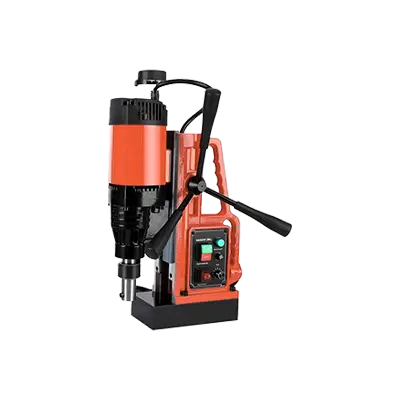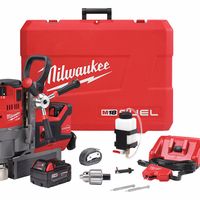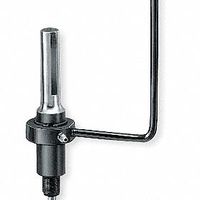Call +(254) 703 030 000 / 751 483 999 / 721 704 777
- Home
- Machining
- Machinery
- Drill Presses Magnetic Drills
- Magnetic Drill Presses
.....Read More
Frequently Asked Questions
What is a magnetic drill press used for?
A magnetic drill press, often referred to as a mag drill, is a specialized portable power tool used for drilling holes in metal surfaces. It is equipped with an electromagnet or permanent magnet base that allows it to adhere securely to ferrous metal surfaces, providing stability and precision during operation. This feature makes it particularly useful for drilling in awkward or vertical positions where traditional drill presses would be impractical.
The primary use of a magnetic drill press is in construction, fabrication, and industrial settings where precise and efficient drilling of large-diameter holes in steel and other metals is required. It is commonly used in the construction of steel structures, bridges, and buildings, as well as in shipbuilding and the manufacturing of heavy machinery.
Mag drills are capable of using various types of cutting tools, including annular cutters, twist drills, and countersinks, allowing for versatility in creating different hole sizes and shapes. Annular cutters are particularly favored for their efficiency in cutting clean, burr-free holes with minimal effort.
The portability of a magnetic drill press makes it ideal for on-site work, reducing the need to transport heavy materials to a stationary drill press. Its ability to drill vertically, horizontally, or overhead expands its utility in diverse applications.
In summary, a magnetic drill press is an essential tool for professionals who require precision drilling in metalwork, offering stability, versatility, and portability for a wide range of industrial and construction applications.
How does a magnetic drill press work?
A magnetic drill press, also known as a mag drill, operates by combining a powerful electromagnet with a portable drilling machine. The core component is the electromagnetic base, which, when activated, creates a strong magnetic field that securely attaches the drill to a ferrous metal surface. This magnetic adhesion allows the drill to remain stable and precise during operation, even when positioned vertically or overhead.
The drill press typically consists of a motor, a spindle, and a chuck or arbor to hold the cutting tool, such as an annular cutter or twist drill bit. The motor powers the spindle, which rotates the cutting tool at variable speeds, depending on the material and the type of bit used. The operator can adjust the speed and feed rate to optimize cutting performance and tool life.
To operate, the user positions the magnetic drill press on the desired drilling location on a metal workpiece. Once the electromagnet is activated, the drill is firmly secured in place. The operator then starts the motor and uses a feed handle to lower the rotating cutting tool into the material. The cutting tool removes material as it penetrates, creating a hole with precision and efficiency.
Some magnetic drill presses are equipped with additional features such as variable speed control, reverse operation, and coolant systems to enhance performance and extend tool life. These features allow for greater versatility and adaptability to different drilling tasks and materials.
Overall, the magnetic drill press is a versatile and efficient tool for drilling holes in metal, particularly in construction, fabrication, and industrial applications where portability and precision are essential.
What are the benefits of using a magnetic drill press?
A magnetic drill press offers several benefits, particularly in industrial and construction settings:
1. **Portability**: Unlike stationary drill presses, magnetic drill presses are portable and can be easily transported to different job sites, allowing for on-site drilling.
2. **Precision and Stability**: The magnetic base provides a strong grip on ferrous metal surfaces, ensuring stability and reducing the risk of the drill bit wandering, which enhances precision.
3. **Versatility**: These drills can be used in various positions, including vertical, horizontal, and overhead, making them suitable for a wide range of applications.
4. **Efficiency**: Magnetic drill presses are designed to drill through tough materials like steel quickly and efficiently, often with less effort compared to manual drilling methods.
5. **Safety**: The magnetic base helps secure the drill in place, reducing the likelihood of accidents caused by slippage or movement during operation.
6. **Time-Saving**: The powerful motor and efficient design allow for faster drilling, which can significantly reduce the time required for projects.
7. **Reduced Operator Fatigue**: The design and functionality of magnetic drill presses minimize the physical strain on operators, allowing for longer periods of use without fatigue.
8. **Adaptability**: Many models come with adjustable speed settings and can accommodate various drill bit sizes, making them adaptable to different tasks and materials.
9. **Cost-Effective**: By improving drilling speed and accuracy, magnetic drill presses can reduce labor costs and material waste, offering a cost-effective solution for drilling needs.
10. **Durability**: Built to withstand heavy-duty use, these drills are typically robust and long-lasting, providing a reliable tool for repeated use in demanding environments.
How do you choose the right magnetic drill press for your needs?
To choose the right magnetic drill press, consider the following factors:
1. **Material and Thickness**: Determine the type and thickness of the material you will be drilling. This will influence the power and type of drill bit required.
2. **Drilling Capacity**: Check the maximum diameter and depth the drill can handle. Ensure it matches your project requirements.
3. **Motor Power**: Higher power motors (measured in watts or horsepower) are suitable for tougher materials and larger holes. Choose a motor that provides sufficient power for your tasks.
4. **Magnetic Strength**: The holding power of the magnet is crucial for stability. Ensure the magnet can securely hold the drill on the material's surface, especially for vertical or overhead drilling.
5. **Speed Settings**: Variable speed settings allow for greater control and adaptability to different materials and bit types. Look for a drill with adjustable speeds.
6. **Portability**: Consider the weight and size of the drill, especially if you need to move it frequently. Lighter models are easier to handle but may offer less power.
7. **Durability and Build Quality**: Opt for a drill made from high-quality materials to ensure longevity and reliability, especially in demanding environments.
8. **Safety Features**: Look for features like overload protection, safety guards, and automatic shut-off to enhance user safety.
9. **Ease of Use**: Features like quick-change chucks, ergonomic handles, and clear controls can make the drill easier to operate.
10. **Budget**: Balance your needs with your budget. While higher-end models offer more features, ensure you are not paying for unnecessary extras.
11. **Brand Reputation and Reviews**: Research brands and read user reviews to gauge reliability and performance.
12. **Warranty and Support**: Check for a good warranty and customer support to protect your investment.
What safety precautions should be taken when using a magnetic drill press?
1. **Personal Protective Equipment (PPE):** Wear safety goggles, gloves, and hearing protection to protect against metal shavings, noise, and accidental contact.
2. **Secure the Workpiece:** Ensure the workpiece is firmly clamped or secured to prevent movement during drilling.
3. **Check the Magnet:** Verify that the magnetic base is clean and fully engaged on a flat, ferrous surface to ensure stability.
4. **Inspect the Drill:** Check the drill bit for wear or damage and ensure it is properly secured in the chuck.
5. **Electrical Safety:** Use a grounded outlet and inspect the power cord for damage. Avoid using the drill in wet conditions to prevent electric shock.
6. **Proper Setup:** Ensure the drill press is set up on a stable surface and that all components are properly aligned.
7. **Use Correct Speed and Pressure:** Adjust the drill speed and apply consistent pressure to avoid overheating or damaging the drill bit.
8. **Keep Area Clean:** Maintain a clean work area free of debris and obstructions to prevent accidents.
9. **Avoid Loose Clothing:** Do not wear loose clothing or jewelry that could get caught in the drill.
10. **Emergency Preparedness:** Know the location of emergency stops and have a plan in case of equipment failure or accidents.
11. **Training and Supervision:** Ensure operators are trained in the use of the magnetic drill press and supervised if inexperienced.
12. **Regular Maintenance:** Perform regular maintenance checks on the drill press to ensure it is in good working condition.
13. **Use Coolant:** Apply cutting fluid or coolant to reduce heat and prolong the life of the drill bit.
14. **Stay Focused:** Remain attentive and avoid distractions while operating the drill press.
Can a magnetic drill press be used on non-ferrous materials?
Yes, a magnetic drill press can be used on non-ferrous materials, but with certain considerations. Magnetic drill presses rely on an electromagnetic base to adhere to the workpiece, which works effectively with ferrous materials like steel and iron due to their magnetic properties. Non-ferrous materials, such as aluminum, copper, and brass, do not have these magnetic properties, so the electromagnetic base will not hold directly.
To use a magnetic drill press on non-ferrous materials, you can employ alternative methods to secure the drill press. One common approach is to attach a ferrous metal plate to the non-ferrous workpiece. The magnetic base of the drill press can then adhere to this plate, providing the necessary stability for drilling. Ensure that the ferrous plate is securely clamped or bolted to the non-ferrous material to prevent movement during operation.
Another option is to use a vacuum base or a mechanical clamping system designed for non-ferrous materials. These systems can provide the necessary stability without relying on magnetic attraction. Vacuum bases create a strong hold by using suction, while mechanical clamps physically secure the drill press to the workpiece.
When drilling non-ferrous materials, it's important to use the appropriate drill bits and cutting speeds. Non-ferrous metals often require different cutting tools and speeds compared to ferrous metals to achieve clean and precise holes. Additionally, using cutting lubricants can help reduce friction and heat, prolonging the life of the drill bit and improving the quality of the cut.
In summary, while a magnetic drill press can be used on non-ferrous materials, it requires additional steps to secure the drill press, such as using a ferrous plate, vacuum base, or mechanical clamps. Proper tooling and techniques are also essential for effective drilling.
What maintenance is required for a magnetic drill press?
1. **Cleaning**: Regularly clean the magnetic drill press to remove metal shavings, dust, and debris. Use a soft brush or compressed air to clean the machine, especially around the motor and magnetic base.
2. **Lubrication**: Lubricate moving parts such as the feed handles, spindle, and gears with appropriate machine oil to ensure smooth operation and prevent rust.
3. **Inspection**: Frequently inspect the power cord, plug, and switches for any signs of wear or damage. Check the magnetic base for any cracks or damage that could affect its holding power.
4. **Magnetic Base Maintenance**: Ensure the magnetic base is clean and free from rust or debris to maintain its holding strength. Use a rust inhibitor if necessary.
5. **Coolant System**: If the drill press has a coolant system, check the coolant levels and top up as needed. Clean the coolant tank and lines to prevent blockages.
6. **Drill Chuck and Arbor**: Regularly check the drill chuck and arbor for wear and tear. Ensure they are tightly secured and replace them if they show signs of damage.
7. **Motor Maintenance**: Periodically check the motor for overheating and unusual noises. Ensure the motor vents are clear of obstructions.
8. **Alignment and Calibration**: Check the alignment of the drill bit and ensure it is perpendicular to the work surface. Calibrate the machine if necessary to maintain accuracy.
9. **Safety Features**: Test safety features such as emergency stop buttons and guards to ensure they are functioning correctly.
10. **Storage**: Store the magnetic drill press in a dry, clean environment to prevent rust and corrosion. Cover it with a dust cover when not in use.
11. **User Manual**: Follow the manufacturer's maintenance schedule and guidelines as outlined in the user manual for specific maintenance tasks and intervals.



